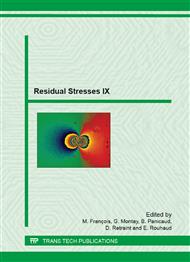[1]
L. -J Xie, J. Schmidt, C. Schmidt, F. Biesinger, 2D FEM estimate of tool wear in turning operation, Wear. 258 (2005) 1479-1490 Issue 10.
DOI: 10.1016/j.wear.2004.11.004
Google Scholar
[2]
P.J. Arrazola, A. Kortabarria, A. Madariaga, J.A. Esnaola, E. Fernandez, C. Cappellini,D. Ulutan, T. Özel, On the machining induced residual stresses in IN718 nickel-based alloy: Experiments and predictions with finite element simulation, Simulation Modelling Practice and Theory. 40 (2014).
DOI: 10.1016/j.simpat.2013.11.009
Google Scholar
[3]
E. Ceretti, L. Filice, D. Umbrello, F. Micari, ALE Simulation of Orthogonal Cutting: a New Approach to Model Heat Transfer Phenomena at the Tool-Chip Interface, CIRP Annals - Manufacturing Technology. 56 (2007) 69–72 Issue 1.
DOI: 10.1016/j.cirp.2007.05.019
Google Scholar
[4]
A. Mondelin, F. Valiorgue, J. Rech, M. Coret, E. Feulvarch, Hybrid model for the prediction of residual stresses induced by 15-5PH steel turning, International Journal of Mechanical Sciences. 58 (2012) 69-85 issue 1.
DOI: 10.1016/j.ijmecsci.2012.03.003
Google Scholar
[5]
F. Valiorgue, J. Rech, H. Hamdi, P. Gilles, J.M. Bergheau, 3D modeling of residual stresses induced in finish turning of an AISI304L stainless steel, International Journal of Machine Tools and Manufacture. 53 (2012) 77-90 issue 1.
DOI: 10.1016/j.ijmachtools.2011.09.011
Google Scholar
[6]
D.N. Arnold, F. Brezzi, M. Fortin, A stable element for the Stokes equations, Calcolo. 21 (1984) 337-344.
DOI: 10.1007/bf02576171
Google Scholar
[7]
T. Heuzé, J.B. Leblond, J.M. Bergheau, E. Feulvarch, A finite element for laminar flow of incompressible fluids with inertia effects and thermo mechanical coupling, European Journal of Computational Mechanics. 19 (2010) 293-304.
DOI: 10.13052/ejcm.19.293-304
Google Scholar
[8]
E. Feulvarch, N. Moulin, P. Saillard, T. Lornage, J. -M. Bergheau, 3D simulation of glass forming process Original Research Article, Journal of Materials Processing Technology. 164-165 (2005) 1197-1203.
DOI: 10.1016/j.jmatprotec.2005.02.135
Google Scholar
[9]
E. Feulvarch, J. -C. Roux, J. -M. Bergheau, A simple and robust moving mesh technique for the finite element simulation of Friction Stir Welding, Original Research Article, Journal of Computational and Applied Mathematics. 246 (2013) 269-277.
DOI: 10.1016/j.cam.2012.07.013
Google Scholar
[10]
A. Mondelin, F. Valiorgue, E. Feulvarch, J. Rech, M. Coret, Calibration of the insert/tool holder thermal contact resistance in stationary 3D turning. Applied Thermal Engineering. 55 (2013) 17-25.
DOI: 10.1016/j.applthermaleng.2013.02.012
Google Scholar


